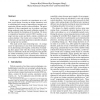Free Online Productivity Tools
i2Speak
i2Symbol
i2OCR
iTex2Img
iWeb2Print
iWeb2Shot
i2Type
iPdf2Split
iPdf2Merge
i2Bopomofo
i2Arabic
i2Style
i2Image
i2PDF
iLatex2Rtf
Sci2ools
95
Voted
RTSS
1996
IEEE
1996
IEEE
Visual assessment of a real-time system design: a case study on a CNC controller
In this paper we describe our experiments on a realtime system design, focusing on design alternatives such as scheduling jitter, sensor-to-output latency, intertask communication schemes and the system utilization. The prime objective of these experiments was to evaluate a real-time design produced using the period calibration method [2] and thus identify the limitations of the method. We chose a computerized numerical control (CNC) machine as our target real-time system and built a realistic controller and a plant simulator. Our results were extracted from a controlled series of more than hundred test controllers obtained by varying four test variables. This study unveils many interesting facts: (1) average sensor-to-output latency is one of the most dominating factors in determining control quality; (2) the effect of scheduling jitter appears only when the average sensor-to-output latency is sufficiently small; and (3) loop processing periods are another dominating factor of perfor...
Average Sensor-to-output Latency | Control Systems | Period Calibration Method | RTSS 1996 | Sensor-to-output Latency |
Related Content
| Added | 07 Aug 2010 |
| Updated | 07 Aug 2010 |
| Type | Conference |
| Year | 1996 |
| Where | RTSS |
| Authors | Namyun Kim, Minsoo Ryu, Seongsoo Hong, Manas Saksena, Chong-Ho Choi, Heonshik Shin |
Comments (0)

